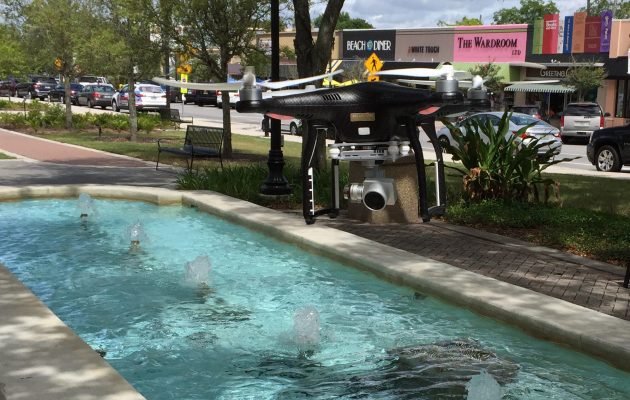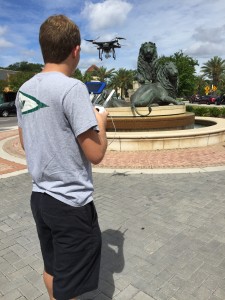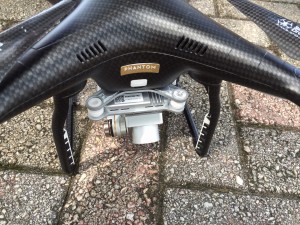The sky has quite the limit
Posted on July 5, 2015 By Editor Articles, Neighborhood News, Riverside, Avondale, Ortega, Murray Hill, Top Stories

As it rested on the ground, its 4k video camera whirred back and forth in a self-check sequence while red, amber, and green lights alternately flashed under the vehicle’s four arms, thus completing its pre-flight electronics check. Four electric motor-driven carbon fiber blades sprang to life, lifting the buzzing little device into a hover inches from the ground. In a moment, it zoomed into the clear, warm spring sky over San Marco Square as operator David Green began video recording ground level and aerial scenes for use in his personal, self-produced “music montage of iconic stuff around Jacksonville.”
 Green, a Jacksonville University student, said that his Phantom 3 Professional quad-copter drone “gives you a new perspective. You can do a lot of stuff you couldn’t before because you don’t need a (camera) jib – you can pop out a drone and (film) quickly.”
Green, a Jacksonville University student, said that his Phantom 3 Professional quad-copter drone “gives you a new perspective. You can do a lot of stuff you couldn’t before because you don’t need a (camera) jib – you can pop out a drone and (film) quickly.”
These latest high tech, small Unmanned Aerial Vehicles – sUAV, or drones, in parlance adopted in the 1990s – follow a near century-long pursuit by both individuals and military to create self-powered, remotely controlled Unmanned Aerial Vehicles (UAV) for use in tasks too dangerous, expensive, or tactically risky to be performed by humans.
A number of discrete systems need to work in harmony for a drone’s flight to be well controlled and safe. The evolution of those systems began over one century ago with inventor Nikolas Tesla’s tele automaton, a radio-controlled boat demonstrated in 1898 by Tesla to an enthralled crowd at New York’s Madison Square Garden.
While Tesla failed to interest the military in using the boat as a type of remote controlled torpedo, the novelty of using radio to control machines would continue. Tesla himself imagined a time when fleets of remote controlled, aerial fighting machines would replace piloted aircraft during military engagements.
Late in World War I in the U.S., the Sperry-Hewitt Autonomous Airplane was developed for bombing runs behind enemy lines. This bi-plane style flying bomb was controlled by a gyroscopic system created by Elmer Sperry and autopilot system developed by early radio control developer, Peter Hewitt. While the Autonomous Airplane did not see combat, its design bolstered the feasibility of Tesla’s idea.
During World War II, it was U.S. bombers against German drones as “Operation Aphrodite” sought to quell Germany’s V1 program. Remote control television guidance systems, installed in “war weary” Liberators and B-17s loaded with explosives, helped remote operators guide the stripped down bombers in attempts to crash them into Germany’s unmanned V1 rocket launch sites and other targets. With this operation came the genesis of the modern drones’ key feature: the live video camera feed.
Through the proving grounds of several more wars and years of advancements in GPS, radio, and optics technology, drones expanded from military operations to become the go-to choice for those seeking bird’s eye views for anything from music videos to real estate speculation.
Using drones for good
Hallmark Partners, Inc. Principal Bryan Weber relates how a drone was used to help develop material for the sales center of Beacon Riverside, an upscale, 15-story condominium tower to be built along the St. Johns River in Riverside. “We have Beacon Riverside elevations and panoramics so we can show clients what their individual views will be. Before this, we’d have to get a helicopter or balloon. The beauty of it is you have video. (Drones are) certainly useful tools when trying to sell views,” he said.
 A commercial photographer with a pilot’s license flew the drone for Beacon Riverside’s pictures and video footage. While the FAA at that time had not solidified drone flight guidelines, Weber said “It still worked well on site” despite several flight restrictions. Weber further stated that drones can be used in real estate development “to preview views of new, potential sites to guide building design.”
A commercial photographer with a pilot’s license flew the drone for Beacon Riverside’s pictures and video footage. While the FAA at that time had not solidified drone flight guidelines, Weber said “It still worked well on site” despite several flight restrictions. Weber further stated that drones can be used in real estate development “to preview views of new, potential sites to guide building design.”
While wireless, self-powered drones offer speedy deployment and ease of use, their light payload rating and relatively short flight times remain unsuitable for use in certain industrial, agricultural, or even military applications.
Enter the tethered drone.
Although it restricts free horizontal flight, tethering offers its own advantages including extended flight time by drawing power from its host, use of military grade optics and surveillance equipment, higher payloads, stability in winds, and compliance with FAA guidelines.
According to their website, Drone Aviation Corp. (DAC) in Jacksonville is “a developer and supplier of unique and specialized aerial solutions to the U.S. Government, State municipalities, and commercial entities.” DAC’s tethered drones, while used in military applications, offer commercial operations robust equipment capable of functioning less than ideal weather and, when properly equipped, at night.
In spite of their usefulness in many arenas, the sight and sound of a high-def camera-equipped drone buzzing across one’s back yard is sure to raise an eyebrow or two. Concerns about flight safety and, more importantly, personal privacy, are at the forefront of burgeoning FAA regulations and local law.
Until this year, ambiguous FAA regulations put off development of novel but viable commercial applications, such as Amazon’s news-leading plan to deliver packages to residences using drones. This plan alone quickened social media wags and bloggers alike to suppose shooting down an Amazon drone, or any other drone, might make for good target practice.
The FAA isn’t amused. In its current iteration of developing guidelines, commercial drone flights – even those involving a small exchange of money – were banned. Planning to upload your drone’s flight footage to YouTube? Expect a post from your friendly, nearby FAA office. Filming for fun, no money, and no fame while flying a drone weighing under 55 lbs., traveling at a velocity under 100 mph, and under 500 feet? Congratulations, you’re a friend of the FAA’s new guidelines. Commercial operators, however, are more than welcome to apply for an exemption, which may be granted if their cause is grand enough. Also, note that shooting down a drone will land you in jail.
Florida’s “Surveillance by a Drone” Bill, signed by Governor Rick Scott this year, and going into effect on July 1st, attempts to address privacy and safety concerns while allowing for immediate, exceptional use by law enforcement officials.
According to the law’s text, anyone flying any drone with an intent to conduct surveillance without prior written consent of the property owner may be find themselves on the wrong end of a civil action. Surveillance in this instance includes:
“…the observation of such persons (anyone on the property) with sufficient visual clarity to be able to obtain information about their identity, habits, conduct, movements, or whereabouts; or…the observation of such property’s physical improvements with sufficient visual clarity to be able to determine unique identifying features or its occupancy by one or more persons.” “Surveillance by a Drone” Ch. 2015-26, Section 1. Section 934.50 e – 1, 2, Florida Statutes (2015)
Coming together for a century, yet still in their infancy in both purpose and law, drones will become an increasingly commonplace sight as technology improves and hardware prices drop. As with most technological advances, drones could be employed equally for good or nefarious activity.
So, for the time being, be like David Green: keep your drone moving, keep it low, keep it slow, keep it free, and the sky is yours.
By Vince Iampietro
Resident Community News




 (1 votes, average: 5.00 out of 5)
(1 votes, average: 5.00 out of 5)




